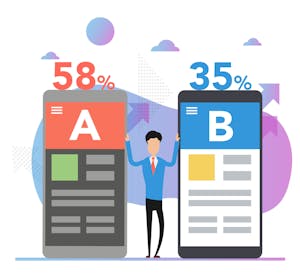- NEW
- 4 minute read
- Digital Marketing
- SEO
- Websites
The Types of Photos You Must Include on Your Tour or Activity Site
Intermediate
Spark is headed to the Big Easy! Join us in New Orleans October 13-15. Registration opens soon!

Digital marketing is driven by data. Which image will increase an email’s click-through rate? Which subject line will get more people to open an email? These are the types of questions marketers ask themselves to help refine their campaigns to get the highest performance possible. The only way to find the answers is through trial and error, and that’s where A/B testing comes in.
A/B testing is a method of evaluating two versions of an element of a marketing asset such as a landing page or marketing email. The purpose of A/B testing is to help understand how small differences in a marketing campaign can influence how customers behave so you can fine-tune your campaigns and make the most of marketing efforts. This guide will cover how A/B testing works, what you can test, and why you should try it.
Rather than trying to guess what your customers will respond to, A/B testing allows you to gather actionable data about your marketing campaigns. To perform an A/B test, marketers select one variable that they want to test, such as the call to action (CTA) or the headline on a landing page. They create two versions of the landing page with the different variables and test them out on a segment of their customers to see which performs better.
A/B tests need to be run simultaneously to account for any variations due to seasonal changes or other time-related variables. For example, if you’re testing a marketing email, you would send version A to a small segment and version B to another segment of the same size at the same time. Next, measure how each version performed, and the winning version is the one you would send to your entire customer base.
Here are some things you can A/B test: 
 Pro tip: It’s important to only test one variable at a time to get a clear understanding of what worked well. If you completely redesign a landing page, you won’t know what did the trick — was it the heading, the CTA, the images, or another element?
Pro tip: It’s important to only test one variable at a time to get a clear understanding of what worked well. If you completely redesign a landing page, you won’t know what did the trick — was it the heading, the CTA, the images, or another element?
Let’s look at a quick example. Say you’re sending a marketing email to promote an upcoming discount on your tours or activities, and you want to figure out which subject line would result in a higher open rate for the email. Without changing anything else in the email, you create two versions with different subject lines.
Version A: Book today and save 20%!
Version B: Hurry! Your 20% discount expires soon.
Next, you create a representative segment of subscribers and send half of them version A and the other half version B. Now you wait for the data to come in. After giving the email a few days, you go back and review the data and find that version A had a 38% open rate, while version B had a 15% open rate. Looks like we have a winner!
Now that you know which version performs better, you can send version A to your entire subscriber base, knowing it has a better chance of bringing in more business.
A/B testing gives you empirical data to guide marketing decisions. Don’t spend your marketing budget on a campaign when you’re not sure what will work for your audience. Conducting these tests gives you the information you need to feel confident you are sending out the most effective marketing campaign for your company and customers. The benefits of A/B testing include:
The goal of any marketing campaign is to increase sales for your company, and when it comes to revenue, you want to feel sure that you’re making the most informed decision possible. Instead of waiting to find out that your marketing campaign didn’t work as well as you wanted it to, A/B testing allows you to get ahead of the game and feel confident that you’re putting your best foot forward.

The process of A/B testing is an effective way to learn from customers. While you might feel like one headline is better than another, trying out your hypotheses through A/B testing gives the data you need to make decisions based on your audience. What works for other companies might not work for you. A/B testing gives you data that’s specific to your business and customers.
Now that you know what A/B testing can do for your company, start thinking about marketing assets and the variables you could test. Even if your marketing assets are already performing well, you might be surprised to learn that they could perform even better with small changes. Ready to keep elevating your digital marketing strategy? Head over to our other marketing guides!